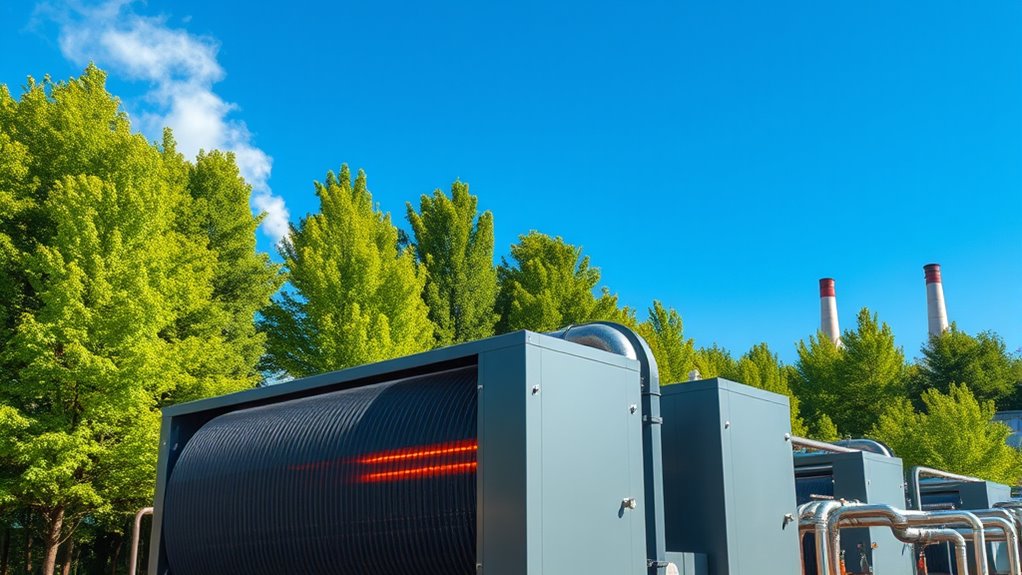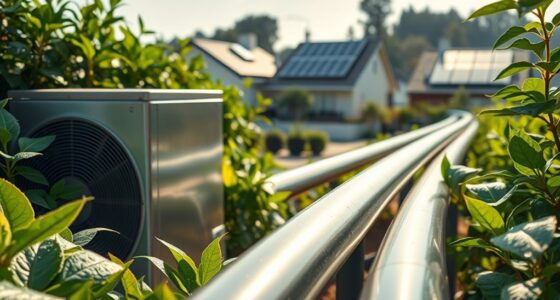Heat pumps enhance biomass energy systems by efficiently transferring heat from low-temperature sources, such as air or ground, to meet heating needs. They work alongside biomass boilers to recover waste heat, boost overall system efficiency, and reduce fuel consumption and emissions. Integrating heat pumps makes these systems more sustainable and adaptable to changing demands. If you explore further, you’ll discover how innovative hybrid solutions are paving the way for cleaner, more efficient renewable heating.
Key Takeaways
- Heat pumps transfer low-grade heat from ambient sources, enhancing overall efficiency when integrated with biomass energy systems.
- They recover waste heat from biomass boiler flue gases, improving heat utilization and reducing fuel consumption.
- Heat pumps provide flexible, renewable heating options that complement biomass systems, supporting sustainable and decentralized energy solutions.
- Integration boosts system efficiency, with heat pumps achieving COPs above 3.0, leading to lower operational costs and emissions.
- Advanced control and hybrid configurations optimize heat exchange, maximizing energy recovery and system performance in biomass energy setups.
Understanding Biomass Energy Systems
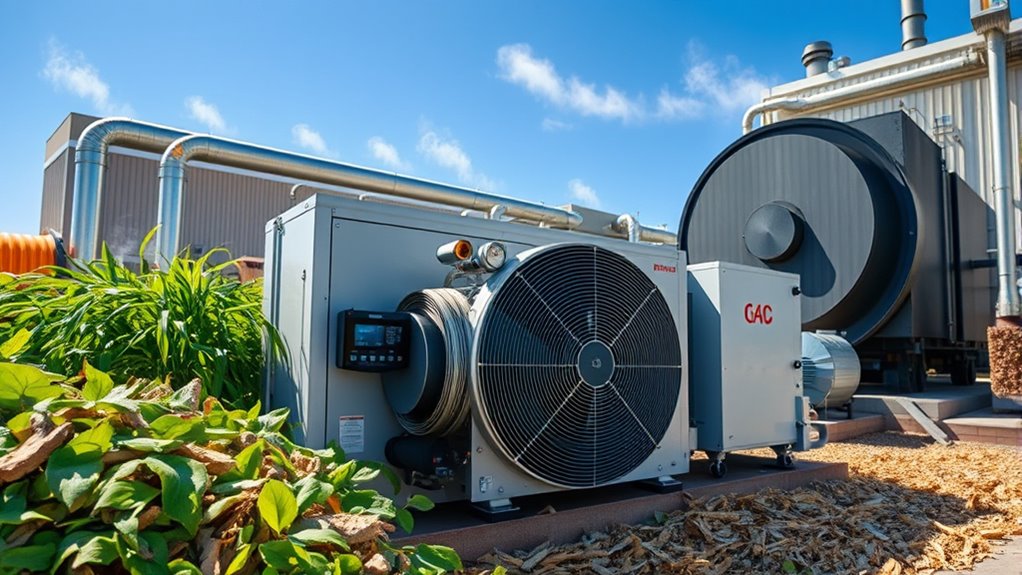
Have you ever wondered how biomass energy systems work? These systems convert biomass—like wood or agricultural residues—into heat or electricity, offering renewable energy options. Modern biomass boilers can reach efficiencies of around 92%, thanks to advanced heat exchangers and thermal integration, which maximize heat recovery and reduce waste. The combustion process releases CO₂, but since the biomass absorbs an equal amount during growth, the process is considered carbon-neutral. The system includes components like fuel storage, feeding mechanisms, and emissions controls. Effective energy systems balance system efficiency with responsible sourcing, ensuring sustainability. When integrated with heat pumps, biomass systems can optimize thermal performance, making them a reliable, eco-friendly alternative to fossil fuels while supporting a cleaner energy future. Additionally, incorporating advanced system components can further improve overall efficiency and environmental impact. For optimal operation, understanding biomass fuel sourcing and its sustainability is crucial to minimize environmental effects and ensure long-term viability.
The Function of Heat Pumps in Renewable Heating
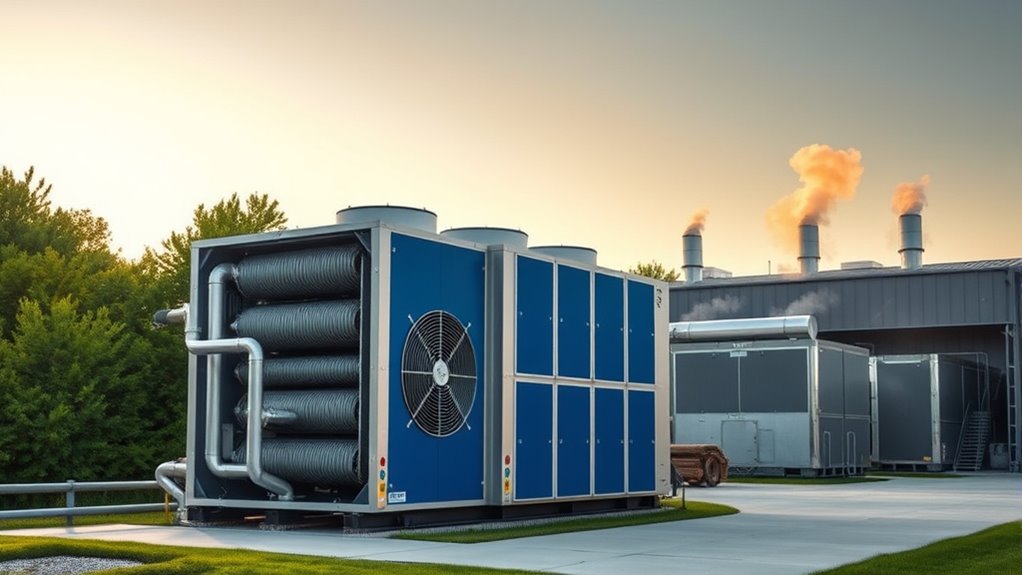
Heat pumps transfer heat from low-temperature sources like air, water, or ground to provide efficient heating. They work by reversing refrigeration cycles, moving heat instead of creating it through combustion, which boosts efficiency. This flexibility allows them to operate effectively even in low temperatures, making them a key component in renewable heating systems.
Heat Transfer Mechanisms
Ever wondered how heat pumps transfer thermal energy in renewable heating systems? It all comes down to the refrigerant and the heat pump cycle, which enables efficient heat transfer from low-temperature sources like air, water, or ground. The refrigerant absorbs heat at the evaporator during a phase change from liquid to gas, capturing thermal energy. It’s then compressed, raising its temperature and pressure, and releases heat during condensation at the condenser, where it transfers heat to the building. The cycle relies on:
- Heat exchange during phase changes in the refrigerant
- Maintaining a temperature difference between sources and the heat pump
- Effective heat transfer through the condenser and evaporator components
- Proper system calibration to ensure optimal performance and energy efficiency
This process maximizes thermal energy transfer, making heat pumps a crucial part of renewable heating solutions. Notably, the Vetted heat pump systems are designed to optimize energy efficiency and durability in various climates. Additionally, the efficiency of heat transfer depends on the quality of the heat exchange components, which are engineered to enhance performance.
Energy Source Flexibility
Did you know that heat pumps can draw energy from a variety of low-temperature renewable sources like ambient air, groundwater, or waste heat? This capability notably enhances energy flexibility in biomass systems by enabling the use of diverse renewable sources. Heat transfer from ambient air, for example, allows these systems to operate efficiently across different temperature ranges. They can recover waste heat and integrate seamlessly into hybrid heating setups, optimizing overall performance. By leveraging low-temperature heat, heat pumps expand the options for renewable energy inputs, supporting system decentralization and diversification. Additionally, modern heat pumps are designed with noise reduction technology that minimizes operational disturbances, making their integration into biomass energy systems more practical and environmentally friendly. This adaptability makes biomass energy systems more resilient to fluctuating energy supplies and facilitates better system integration, ensuring system reliability and sustainable heating solutions that utilize renewable sources effectively and efficiently. Furthermore, the ability to efficiently utilize ambient heat enhances the overall robustness of renewable heating systems, making them more adaptable to varying environmental conditions. Incorporating innovative heat exchange methods can further improve the efficiency of these systems under different operational scenarios, especially when combined with advanced control systems for optimal performance.
Efficiency in Low Temps
How do heat pumps maintain high efficiency even in low ambient temperatures? They excel at low-temperature operation by effectively transferring heat from sources like the air, groundwater, or waste heat, ensuring steady performance in colder climates. Their design, including advanced refrigerant cycles, maximizes heat transfer and sustains high COP values, often above 3.0. This enables reliable renewable heating and seamless system integration with biomass energy systems. To optimize low-temperature performance, modern heat pumps incorporate:
- Efficient compression and absorption technologies
- Smart control systems for precise operation
- Compatibility with biomass networks for waste heat utilization
- Proper maintenance practices that prevent efficiency losses and help sustain optimal performance during cold weather. Implementing regular servicing is crucial for maintaining high efficiency and prolonging system lifespan. Additionally, incorporating advanced insulation techniques can help reduce heat loss and improve overall system efficiency. These features help preserve heat pump efficiency, reduce reliance on combustion, and ensure consistent heating even during frigid weather. Moreover, integrating smart control systems allows for better adaptation to changing environmental conditions, further enhancing low-temperature performance.
Benefits of Integrating Heat Pumps With Biomass Boilers
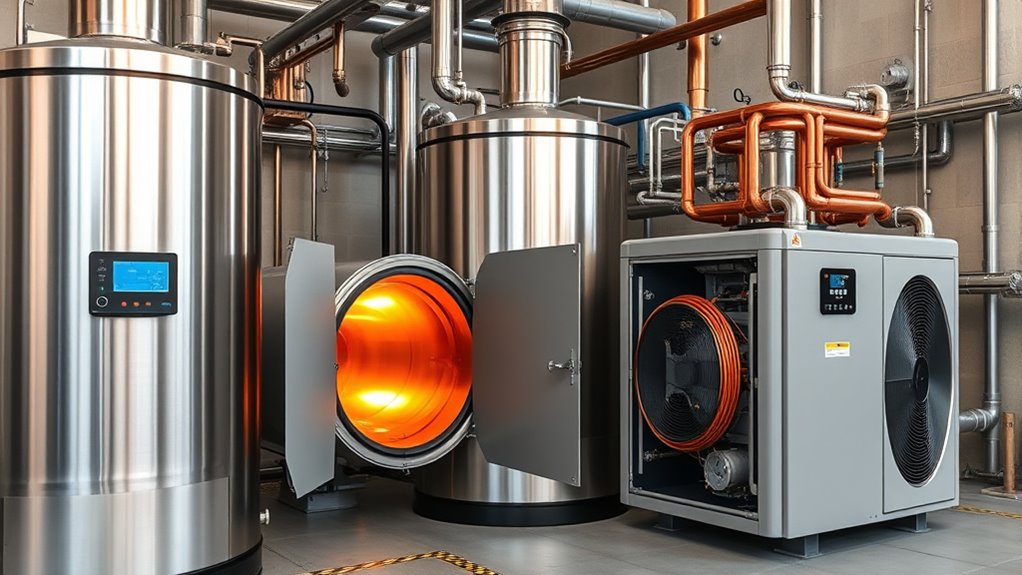
By integrating heat pumps with biomass boilers, you can substantially boost your system’s efficiency through better waste heat recovery. This combination also helps lower operational costs by optimizing energy use and reducing reliance on fossil fuels. As a result, you get a more sustainable, cost-effective heating solution that adapts to varying demands. Additionally, incorporating renewable energy technologies like heat pumps can further reduce environmental impacts and enhance long-term energy resilience. Proper system integration ensures that both technologies operate harmoniously, maximizing overall performance and reliability. Furthermore, utilizing energy storage solutions can help balance supply and demand, increasing system flexibility and efficiency. Incorporating coastal environment considerations can also help in designing resilient systems that withstand local weather conditions.
Enhanced System Efficiency
Have you considered how integrating heat pumps with biomass boilers can substantially boost system efficiency? This approach enhances waste heat recovery from flue gases, utilizing heat exchangers and condensers to capture low-grade heat. The benefits include:
- Improved system efficiency through better utilization of flue gas heat
- Increased renewable energy utilization, reducing fossil fuel dependence
- Notable efficiency improvements of over 12%, lowering operational costs
- Proper system maintenance ensures optimal performance and longevity of integrated components
- Incorporating subconscious power during sleep techniques can further optimize system performance by aligning operational goals with vibrational energy, leading to more effective energy management and better overall results
- Additionally, implementing advanced control systems can optimize the operation of heat pumps and biomass boilers, ensuring maximum efficiency under varying load conditions and leveraging genetic predispositions to improve system adaptability.
- Understanding vetted solutions in renewable energy integration can help identify the most effective configurations for specific applications.
Lower Operating Costs
Integrating heat pumps with biomass boilers can lead to significant reductions in operational costs. By utilizing waste heat, heat pumps boost system efficiency and lower fuel consumption. This system integration enables heat recovery, which maximizes energy savings and reduces dependence on biomass fuels. With a COP typically between 3.0 and 4.0, heat pumps provide more heat output per unit of electricity, further lowering expenses. When biomass fuel costs fluctuate, this setup stabilizes operating costs by optimizing heat recovery and minimizing fuel use. Additionally, regular maintenance and system optimization can further enhance the overall performance and cost-effectiveness of the combined system. Moreover, advancements in cybersecurity are crucial for protecting control systems and data integrity in modern biomass energy setups. Overall, studies show that combining heat pumps with biomass boilers can improve total system efficiency by about 11-13%, resulting in substantial cost savings over time.
Environmental Impact and Sustainability Aspects
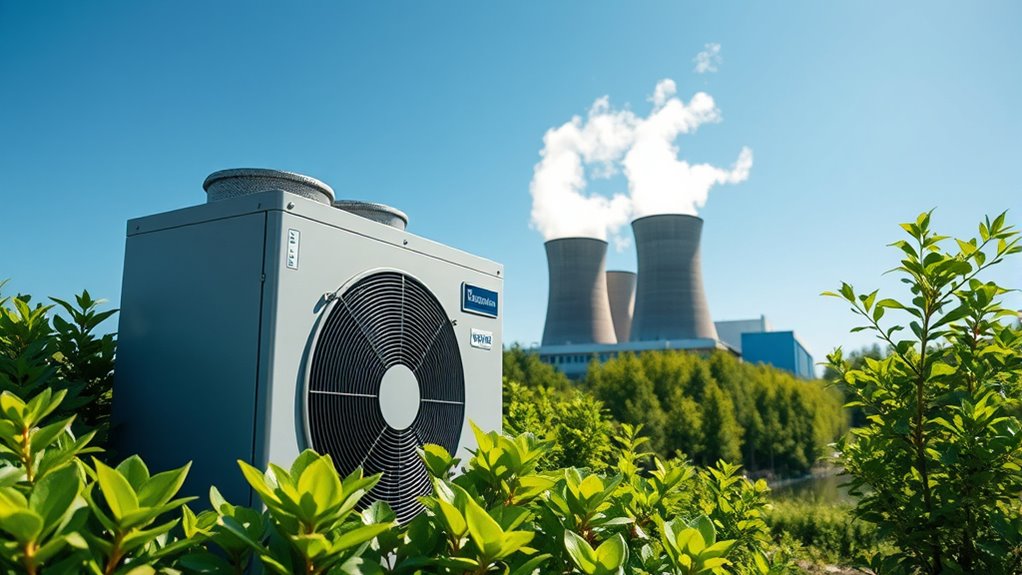
How do heat pumps enhance the environmental sustainability of biomass energy systems? They produce no direct carbon emissions, markedly lowering your system’s environmental footprint. When powered by renewable electricity, heat pumps can reach near-zero life cycle emissions, boosting overall sustainability. Integrating heat pumps improves energy efficiency, reducing resource consumption and supporting climate change mitigation. Proper biomass sourcing keeps the system carbon-neutral and eco-friendly. Additionally, utilizing advanced heat pump technology can further optimize performance and environmental benefits. Here are some key benefits:
- Minimize carbon emissions and environmental impact
- Achieve near-zero lifecycle emissions with renewable power
- Enhance sustainability through increased energy efficiency
This combination helps you meet EU greenhouse gas targets while maintaining a low resource footprint. By aligning heat pumps with biomass systems, you support a cleaner, more sustainable energy future with reduced climate change effects.
Comparing Heat Pumps and Traditional Heating Solutions
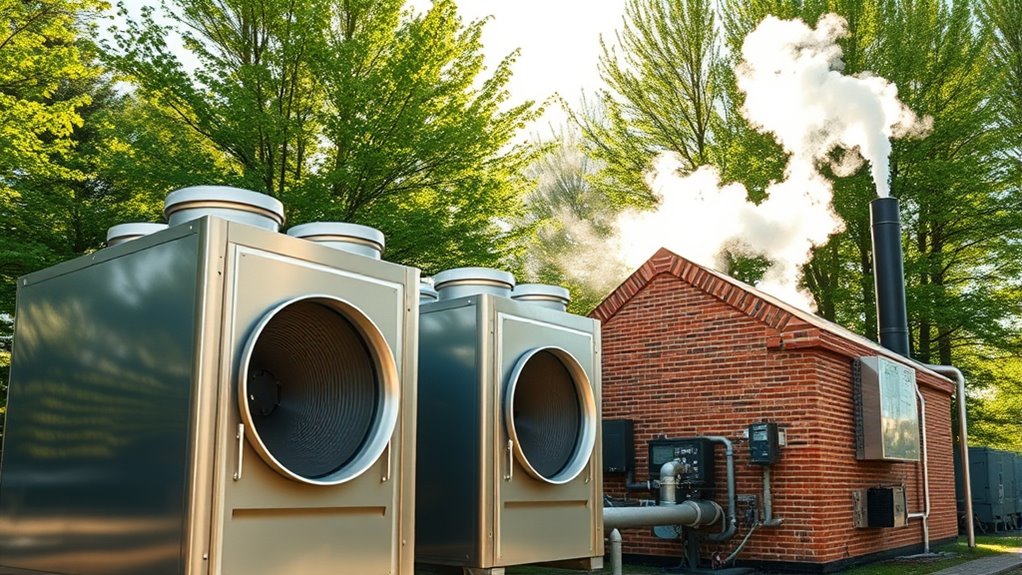
Heat pumps stand out as a modern alternative to traditional biomass heating solutions, offering significant advantages in efficiency and environmental impact. Unlike biomass boilers, which typically reach around 92% efficiency, heat pumps can exceed 300%, producing more heat from less electricity. They transfer ambient environmental heat, reducing fuel consumption and direct emissions, making them a cleaner option. While biomass systems depend on fuel storage and combustion, heat pumps require only electricity and minimal space, simplifying system integration. Maintenance for heat pumps is generally lower, and their lifespan outlasts biomass boilers—15 to 25 years versus 8 to 12. Operational costs vary with electricity prices, but overall, heat pumps provide a more sustainable, efficient, and less labor-intensive heating solution compared to traditional biomass boilers.
Design Considerations for Hybrid Biomass-Heat Pump Systems
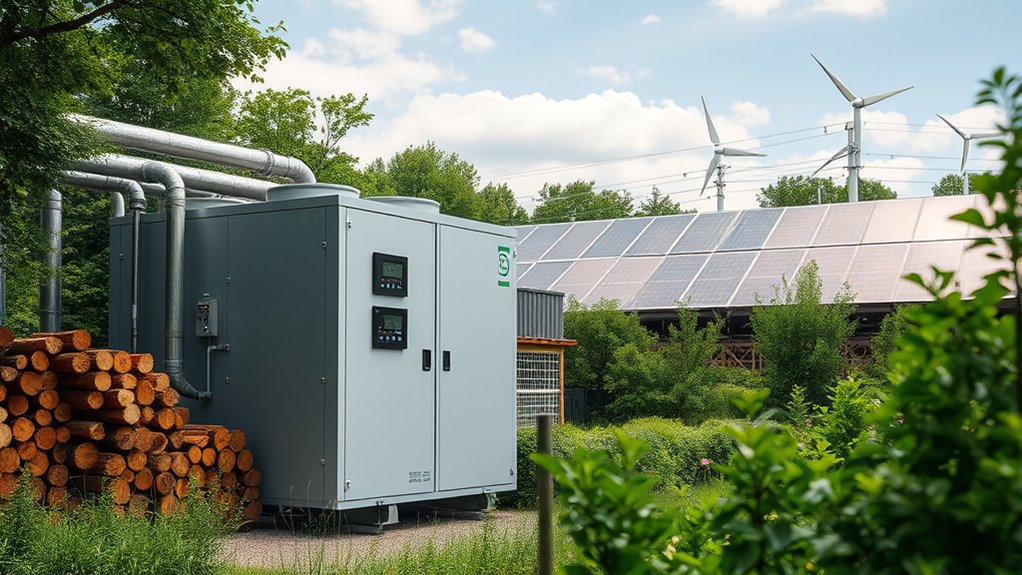
Designing hybrid biomass-heat pump systems requires careful selection of connection points, such as flue gas or network return flow, to maximize heat recovery efficiency. You need to contemplate heat pump integration and optimize heat recovery by managing exhaust gas temperature and return flow. Focus on system capacity matching to ensure balanced operation and prevent issues like high return temperatures exceeding dew points. Effective design also involves thermodynamic modeling and using optimization algorithms to identify the best configurations under changing conditions. Keep in mind biomass fuel properties, like moisture content, which impact heat recovery potential. To enhance system efficiency, pay attention to:
- Connection points for effective heat transfer
- Return flow management to prevent overheating
- System capacity matching for reliable operation
Future Trends and Innovations in Biomass and Heat Pump Technologies
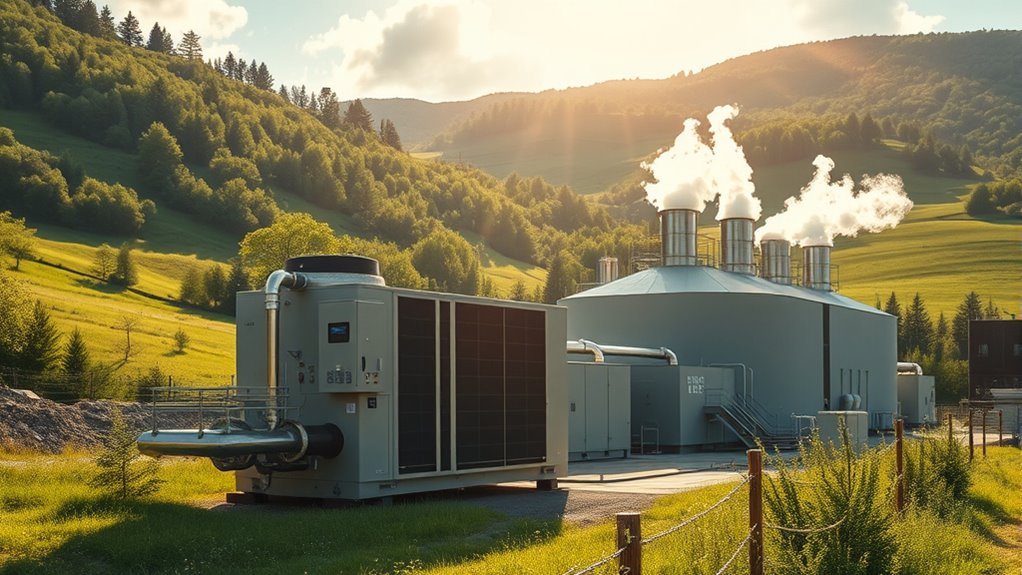
Advancements in hybrid biomass and heat pump systems are driving a new wave of innovation aimed at boosting efficiency and reducing environmental impacts. Emerging hybrid systems combine biomass boilers with advanced heat pumps, optimizing renewable energy use and enhancing energy efficiency. Innovations in low-GWP refrigerants and improved cycle designs increase environmental sustainability and system performance. Smart control algorithms and AI-driven optimization enable adaptive operation, managing dynamic energy demands effectively. Researchers are exploring next-generation heat pumps utilizing sorption or thermoelectric technologies to perform better at lower temperatures and integrate seamlessly with biomass systems. Future trends include modular, scalable heat pump units that can be easily incorporated into existing biomass infrastructure, supporting decentralized, flexible, and sustainable heating solutions aligned with evolving system integration and renewable energy goals.
Frequently Asked Questions
What Is a Biomass Heat Pump?
A biomass heat pump is a device that uses renewable biomass fuels to produce heat efficiently. You can think of it as combining biomass combustion or gases with heat pump technology to maximize energy use. It recovers heat from biomass processes or uses biomass gases as a low-temperature heat source. By doing this, you reduce reliance on fossil fuels and lower your carbon footprint while maintaining effective, sustainable heating.
What Is the Purpose of a Heat Pump System?
When it comes to understanding the purpose of a heat pump system, you’re really getting to the heart of efficiency. Its main goal is to transfer heat from a low-temperature source, like air or water, to heat your space or water more efficiently. You’re fundamentally making the most of what’s available, turning a small input into a big output. This helps lower energy bills and cuts down on greenhouse gases, making it a win-win.
How Do Heat Pumps Reduce Carbon Emissions?
You can see that heat pumps reduce carbon emissions by transferring ambient or low-grade heat instead of burning fossil fuels. When powered by renewable electricity, they produce almost no direct CO₂ emissions. By replacing traditional boilers, you cut down on combustion-related greenhouse gases. Additionally, integrating heat pumps with renewable energy sources like wind and solar further decreases the carbon footprint of your heating system, making it more sustainable.
What Is the Function of Heat Pump in Geothermal Power Plant?
You might wonder what a heat pump does in a geothermal power plant. Its main function is to upgrade low-temperature geothermal heat to higher temperatures, making it suitable for electricity generation or direct heating. It transfers heat from the geothermal source to a working fluid using a refrigeration cycle, improving efficiency. This allows you to utilize lower-temperature resources, expand project feasibility, and optimize heat extraction for better energy output.
Conclusion
By combining heat pumps with biomass systems, you’re creating a more efficient, sustainable heating solution. This hybrid approach can reduce your carbon footprint and optimize energy use. Remember, a chain is only as strong as its weakest link—so integrating these technologies thoughtfully guarantees you get the best of both worlds. Embracing innovation today sets you up for a greener, more resilient energy future tomorrow.
